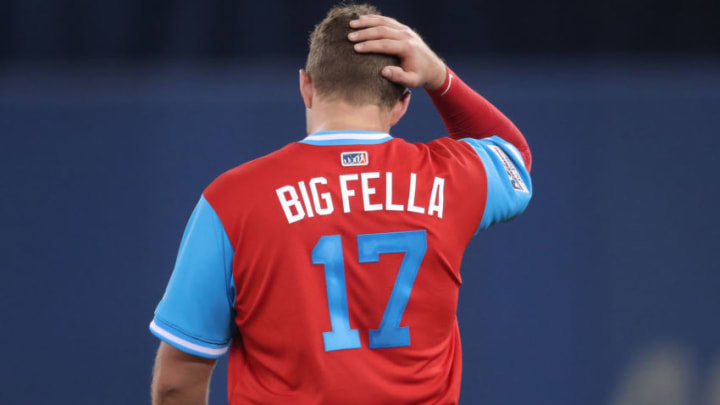
Now that the Philadelphia Phillies have been eliminated, let us look at which members of the roster will remain with the team next year.
Now that the Philadelphia Phillies have upheld the laws of probability by crashing and burning in a 0-4 series with the Atlanta Braves, it is time for a team post-mortem. It appeared nearly impossible for the Phillies to pull off a divisional championship just a few days ago, but after they jumped off a very high bridge down south, it seems appropriate to indicate who should stay and who should go from the core team.
This analysis will not include the on-field managerial staff (perhaps another day) or all of the bullpen since at last count, 589 players comprised the Phillies relief staff, and clearly some of them are actually minor leaguers who got look-sees because – why not? Some relievers will be addressed here. Not all starting pitchers will be addressed if they did not settle into significant roles in the rotation.
Starting Pitchers
It is widely and correctly asserted that the following five players kept the Phillies in first place for about five weeks and, possibly, over .500 for the season:
Aaron Nola – Why not start with the obvious? No team dumps a potential Cy Young awardee. The only question remaining is whether or not Nola should make his last start. At 16-6, he shouldn’t. There’s nothing magical about a 17th win, and he’s looked a bit tired in passing 200 innings. Preserve his health and his sterling 0.979 WHIP. Of all players on the roster, Nola gets the strongest keep label on the team.
Jake Arrieta – Potentially removing Arrieta could be one of the hardest decisions if somehow the Phillies were offered an everyday player of the caliber of Lorenzo Cain, but don’t bet on that kind of trade even if you infer the Phillies eating some of Arrieta’s $25 million contract for next year and some for 2020. With one start to go, Arrieta’s winning percentage, WHIP, and FIP figures have all slipped below his career averages, but he is a competitor, and could make the team more attractive to potential high-caliber recruits like Manny Machado or Bryce Harper. Keep Arrieta. (And don’t even think of moving him for a bunch of “promising young players.” Phillies fans, who voted to keep their wallets closed this summer, even when the team was in first place, have had it with that.)
Zach Eflin – Of the three pitchers who settled into the rotation as the back end, Eflin has the best record moving into the season’s last week (11-8, 4.36 ERA, 1.305 WHIP). Additionally, his FIP figure this season is better than his career figure by 1.00 (after play Sept. 24). Of the pitchers who became no. 3, no. 4 and no. 5 in the rotation, Eflin should be the third to be dangled in trade discussions, behind the next two players listed. Keep Eflin unless offered a clear upgrade in a clear need area.
Nick Pivetta – Despite sporting the worst won-lost record at the back end (7-13), Pivetta is the youngest of them, has the best WHIP (before play Sept. 25) and maybe the highest ceiling. As with Eflin, keep Pivetta unless….
Vince Velasquez – Vinny Velo is a mystery. He has overpowering, no-hit potential, but after sizable parts of four seasons in MLB, he still has a losing record, and while his career WHIP is zig-zagging downward, it is still 1.344. Velasquez is perhaps the most obvious player on the roster who might benefit from a change of scenery. He will also turn 27 before the midway point of next season. Velasquez is arbitration eligible after the season; strongly consider non-tendering him, or if management is still indecisive in December, work through arbitration and trade him if possible.
The only other pitcher to start as many as five games for the ’18 Phillies, Ben Lively, was claimed off waivers by Kansas City this month. If somehow the Phillies moved Velasquez, Pivetta or Eflin only and acquired no other starter, they would be moving into spring training with Triple-A left-hander Cole Irvin as their tentative fifth starter, but no team actually admits to such clear designations in February. Irvin (14-4, 2.57 ERA, 1.054 WHIP) should be kept.
